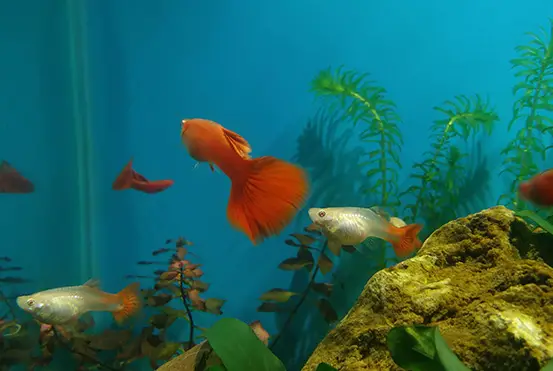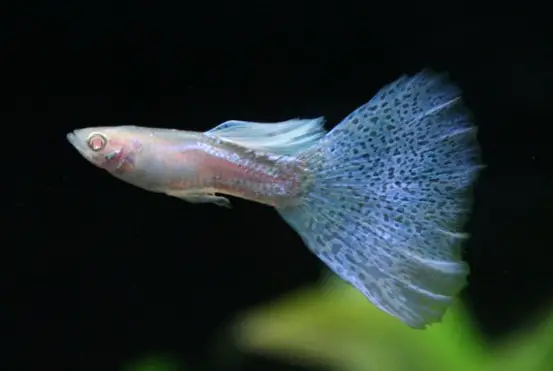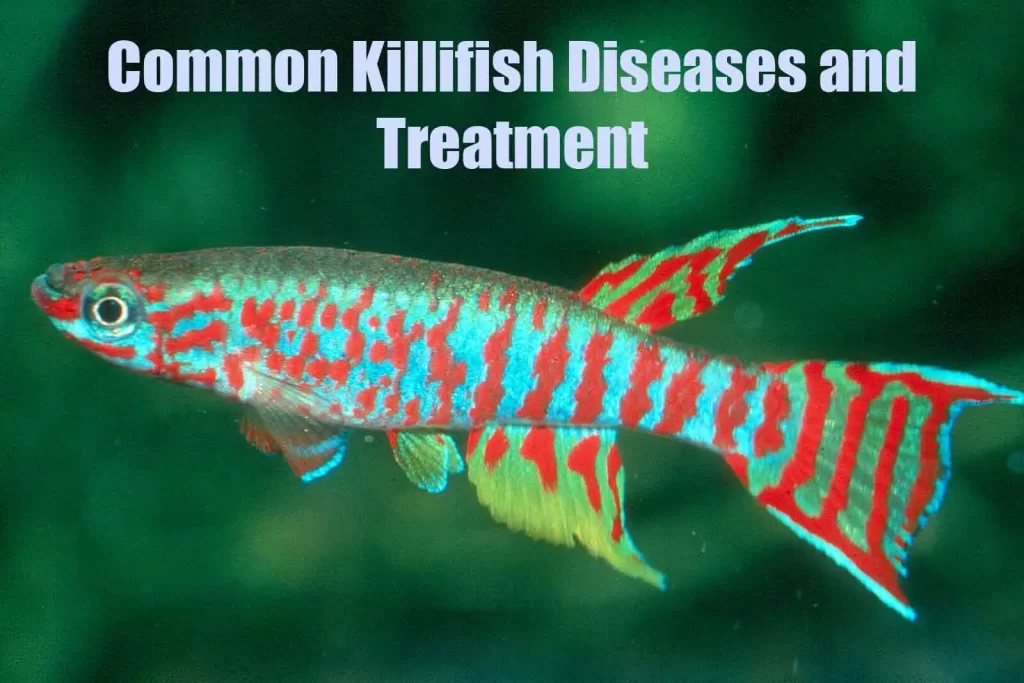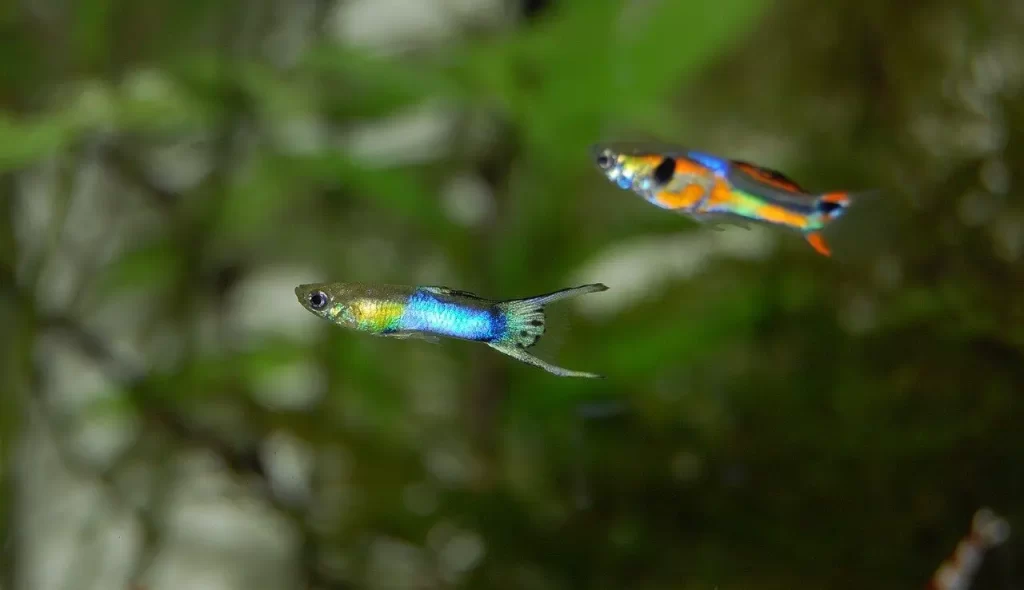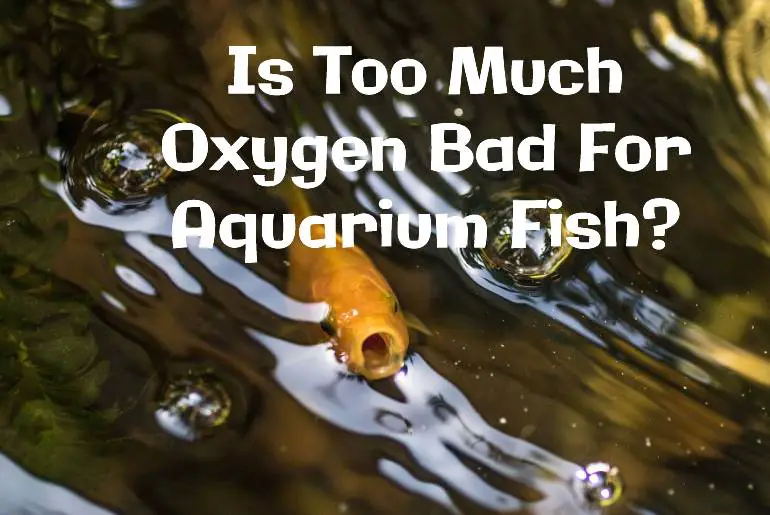Guppies and other livebearer fish are generally hardy fish. They can tolerate a wide range of water parameters. These hardy fish don’t get sick much. Although they are affected by only a few diseases, if you properly set up your fish tank and you are providing them an excellent food diet, then your guppy fish should be healthy enough to fight off most of the guppy disease and treatment would be minimum.
Guppy fish suffers from more than one disease that are Ich (white spot disease), a fungus disease, fin and tail rot disease, dropsy disease, velvet or gold dust disease, and flukes, and their treatment ranges from simple antibiotics to maintaining water parameters of the tank.
List of Common Guppy Disease and Treatment
In this section, I will discuss some of the most common guppy diseases, symptoms, causes, and treatments, specifically, guppy disease and treatment. Before going through this section, first, make sure that you have correctly diagnosed the right disease that your fish is suffering from. Else treating the disease with the wrong treatment will negatively affect your fish.
This article will not only help you to heal your sick guppy fish but also prevent any disease from starting again in the future i.e., prevention is better than cure. Regular maintenance with proper aquarium setup must be done to prevent many diseases from breaking out in your fish aquarium.
The first thing you must do after you witness the symptoms of sickness is to remove the sick fish to a quarantine or hospital tank so that other fish won’t get affected.
It’s always better to treat the disease early to prevent it from spreading and help recover quickly. Make sure you remove any type of chemical media like activated carbon from your filter since
Activated carbon absorbs and helps to remove medicine. Also, ensure that you give the recommended amount of medication as indicated on the medicine packaging, as overdosage could result in toxins in your tank water, eventually killing your fish.
Below is a list of the most common guppy diseases and treatments:
Ick/ Ich
Ick is a disease that causes your fish to get small white spots on their body. This disease is commonly famous as white spot disease and Ich. Ick is caused by protozoa named Ichthyophthirius Multifilis. This parasite spends part of its life within fish skin, creating white crysts on the skin of fish. Once these crysts are mature enough, they fall down to the substrate and give rise to thousands of new swimming parasites.
Symptoms
- Small white dots appearing in the fish body,
- The fish may try to rub its body against hard surface or decorations in the aquarium,
- They will look uncomfortable and have a loss of desire for food.
Cause
- caused by protozoa named Ichthyophthirius Multifilis,
- rapid fluctuation of temperature and PH of water level causing white-spot disease,
- poor maintenance and water quality.
Treatment
- Since parasites are released into the water, clean the entire tank,
- Raise the temperature slightly to speed up the life cycle of the parasite,
- Add aquarium salt at the rate of 5-8 tbs per gallon,
- Malachite Green and formalin mixture can be used to control the parasite.
Prevention
- Do not make drastic water temperature changes and keep the water temperature warm,
- Not overcrowding the fish,
- Regular water changes and filters.
Medicine for Ich
Kordon #37344 Methylene Blue-General Disease Prevention Treatment for Aquarium, 4-Ounce
API SUPER ICK CURE Fish remedy
Dropsy
Dropsy is a disease that causes your fish to get a swollen abdomen filled with liquid and a body with raised scales. Viruses and bacterial infections cause Dropsy.
Once Dropsy reaches the kidney, the disease will become almost incurable, leading to the fish’s death. Therefore, only if you discover this disease early, you probably can save your fish. It is because Dropsy is one of the diseases that is almost incurable.
Symptoms
- The sick fish will have a big swollen body with its scale raised,
- The fish appear listless,
- Loss of appetite is seen.
Cause
- poor quality of water,
- feeding infected fish food to your fish,
- Dropsy can be genetic in nature,
- Dropsy is caused by an infection from bacteria.
Treatment
- Remove the fish immediately after the disease is discovered in a quarantine tank to avoid spreading the bacteria into the main tank,
- Dropsy is typically one of the incurable diseases, by the time the symptoms of Dropsy are visible, and it’s too late to cure the fish since most of its internal organs are already damaged due to infection.
Prevention
- Always balance your pH in your fish tank; Guppy requires a pH rating of 5.5 to 8.5,
- In case of the absence of bacterial infection, it can be cured by providing quality food and environment,
- Clean water helps a lot in preventing further infections.
Always treat your water using API melafix fish remedy for bacterial infection.
Fin Rot / Tail Rot
As the name suggests, fin or tail rot is a disease that causes the fins to turn opaque or blood-streaked. The fish dies when the erosion of the fin reaches the base of the fin. The bacteria that cause fin or tail rot generally do not affect healthy fish. Fin rot starts to attack a fish when the guppy fish are stressed or when the fin is damaged due to extreme fin nipping.
Symptoms
- Rotting of fish fins or tails,
- Fish’s fins or tail looks like torn with a white edge or red blood-streaked,
- Guppy will look like they have missing fins or tail.
Cause
- caused due to excessive fin nipping, which invites stress and bacterial and fungal infection,
- keeping the Guppy in an overcrowded tank,
- poor water quality causes bacteria to grow, attacking a weak fish.
Treatment
- Identify the cause in order to treat the fish,
- For bacterial infection, use a commonly available antibiotic as medication: API melafix fish remedy for bacterial infection,
- The fungus can be treated by special medicines: API fin and body cure,
- For ammonia burns, provide high-quality water,
- Use bathing techniques to helps the fish to relax.
Prevention
- Separate any fish that has been bullied or fish with its fins nipped to the hospital tank,
- Frequent water change helps a lot to overcome most of the disease,
- Maintain and monitor the tank and fish properly.
Learn more about the fin-rot disease and its treatment.
Fungus
A fungus is a colorless plant that appears on the fins or body in the form of whitish cotton-wool. Fungus attack is most common in sick and weak fish with previous skin or fin damage.
Symptoms
- Whitish cotton-wool growth appears in fish body or fins,
- Stress due to damage or shifting,
- Fungi are typically secondary infections.
Cause
- caused due to excessive fin nipping or wound in the body or gills,
- the weak immune system,
- the fungus also occurs in fish when you keep them in water that is too cold.
Treatment
- Antifungal medicines are available in most of the pet stores to fight bacteria,
- Increasing the temperature slightly can provide double protection,
- Various water treatments must be used like Methylene blue, Acriflavine, and many more,
- Gradually add aquarium salt in your hospital tank one tbs per gallon,
- Remove half of the tank water every 2-3 days and add chlorine-free water at the correct temperature. Use tap water declorinator.
Prevention
- Always add aquarium salt to your aquarium while doing a water change,
- Check your water hardness, temperature, and toxic level,
- Always keep an antifungal medicine in your table drawer.
Medicine to Cure Fungus
API Melafix Fish Remedy for Bacterial Infection in Freshwater Aquarium
API PIMAFIX Antifungal Freshwater and Saltwater Fish Remedy
Couluminaris
Columinaris is a bacterial infection that appears to mimic fungus. This bacteria forms a white cotton mold-like structure near the mouth or the mid area of the body. Columinaris in guppies mostly affects females, leading to muscle paralysis and spreading slowly. Do not mistake Culuminaris for fungal infection as it is contagious, so treatment is required immediately.
Symptoms
- Initially, the fish gets frayed and ragged fins,
- Gill discoloration,
- White cotton or cloudy structure formation near gill filaments,
- Loss of appetite,
- Fish is having a problem while swimming.
Causes
- stress due to various reasons,
- inadequate diet and environment,
- bacteria entering through either gills, mouth, or wound.
Treatment
- Provide a medicine bath (30 minutes of potassium permanganate bath or Terramycin bath),
- Adding aquarium salt to the tank can reduce the disease ( 3 tsp per gallon),
- Medications like praziquantel or Formalin in certain doses can also help,
- Make sure the Guppy gets enough minerals,
- Maintain temperature at 37 °C,
- Perform regular water changes after treatment.
Prevention
- Regular water maintenance followed by water changes,
- Place the Guppy in a quarantine tank to reduce spreading,
- Disinfection of tank before use.
Gill Disease
Gill Flukes disease or gill disease makes a fish have rapid fin movement for a faster swim, even when they are not swimming at all. In the early stage, fish suffering from gill disease tends to hang out on the bottom of your tank with their gills opened. This is due to worms in the gills, which a gill biopsy can detect.
Symptoms
- Fish tends to flap their fins very fast and appears to swim in a great hurry,
- You can often notice swollen and discolored gills,
- The gills will look like they are bleeding due to bacterial infection,
- Eroded fins,
- Your fish will have a lot of trouble breathing.
Cause
- poor water quality is the main cause of bacterial infection,
- chlorine in water often irritates the gills of the fish,
- bacteria, fungi, and other parasites in the water cause gill flukes,
- excessive mucus production.
Treatment
- Anti-bacterial medicine is used to cure bacterial disease, that is easily available at your local fish store: API melafix fish remedy for bacterial infection,
- A frequent water change is required since immediate water quality improvement is needed in the preliminary step,
- Make sure that you dechlorinate your water first.
Prevention
- Usually, new fish or plants in your tank introduce the disease; quarantine your new fish or plant before adding it to your tank,
- Quality feed and carbon filtering also help prevent organism formation,
- Water quality is a must in your closed container, hence requiring frequent water changes is very important,
- Detection at early stages can be cured; however, once the gills start bleeding, you can’t save your fish.
Fish Pop-eye
If you notice either one or both of your fish eyes swollen or sticking out abnormally, it is a condition, Popeye. Popeye is a common disease among guppies, which causes the eye of the fish to appear cloudy along with an evident swell. Also famous as exophthalmia, the disease can originate from various factors. However, if only one eye is affected, the condition is likely caused by an injury. Fish Pop-eye can lead to permanent blindness and is hard to cure.
Symptoms
- The area surrounding the eye appears protruded,
- Lethargy,
- Cloudy or discolored eye.
Cause
- poor water maintenance,
- the primary cause is a bacterial infection,
- Dropsy, fungus, Tuberculosis, and other internal parasites lead to the condition.
Treatment
- Regularly monitor your fish and make water changes of about 24%.
- Feed antibiotic and nutritious food API melafix fish remedy for bacterial infection.
- Veterinarians usually recommend Skin and gill biopsies for Parasite infestations.
Prevention
- Isolation of Guppy in a new tank,
- Regular water changes followed by pH maintenance,
- Keeping water slightly acidic.
Velvet
Also called gold dust, rust, and coral disease is a parasitic disease caused by Oodinium, a parasite, in freshwater fish. The host develops a dusty, brownish-gold color scattered on the head, fins, and body. Velvet disease is similar to ick but is difficult to notice in the early stage. This disease is highly contagious. I highly suggest you keep infected guppies in a hospital tank.
Symptoms
- Development of yellow or gold-colored spots on the body,
- Rubbing and scratching of the body against hard objects,
- Loss of appetite and weight loss,
- Fins clamped against the body,
- In severe stages, there can be bleeding or peeling of the skin.
Cause
- parasitic organisms like Oodinium latch onto the fish,
- fluctuating factors in the tank, causing stress.
Treatment
- Switch to a dark light setting in the aquarium,
- You can use Copper medication on prescription,
- When symptoms are cured, perform 70-90% water changes.
Prevention
- Regular water changes and maintenance.
- Regular water testing with pH testing and hardness can maintain water quality,
- Do not overcrowd your tank,
- Feed small quantities of fresh, high-quality food.
Viral Haemorrhagic Septicaemia (VHS)
VHS is a deadly infectious fish disease in guppy caused by a gene-originated virus called ‘Piscine novirhabdovirus’ and has no known treatment. This virus is highly contagious. The primary stages of VHS include lesions on the body. Ulcers and sores where the fins will start rotting will follow this disease. The fish will eventually stop eating and become darker in color. VHS may also lead to red spots.
Symptoms
- The gills turn pale, and eyes start to bulge,
- Loss of appetite,
- Fish turns dark in color,
- Rotting of fins.
Causes
- genetic transfer of virus,
- exposure to infected fish,
- because Guppies exhibit cannibalism, the eggs or infected fish, if eaten by others, will result in VHS.
Treatment
- The exact treatment for VHS is undetermined,
- Aid with medications like antibiotics,
- Perform water changes in a large amount.
Prevention
- Introduce new fish to the quarantine tank first,
- Disinfecting the tanks before use,
- Maintain water quality and feed.
Guppy Disease (Tetrahymena)
Guppy Disease is a disease commonly found in the Guppies with a very simple treatment plan. The parasite behind this is called ‘Protozoan,’ which has the ability to affect other fish in your tank. This disease appears to look like an Ich but causes death faster. You can identify Guppy disease by white or grayish spots on the fish’s body. In some cases, an infected guppy can appear healthy one day and ends up dead the next. Therefore, one can only identify it microscopically.
Symptoms
- The appearance of white spot-like cysts on flanks and fins,
- Heavy breathing of the fish,
- Lethargy in movement,
- Clamped fins.
Causes
- bad quality of water,
- inadequate diet,
- due to stress while transferring,
- the infected batch of fish.
Treatment
- Use multipurpose anti-protozoan medications such as Clout,
- There is no particular treatment to cure Guppy disease,
- You can use medications like niclosamide, albendazole, and chloroquine to decrease the parasite, followed by 2 hours of exposure.
Prevention
- Select new livestock carefully,
- Quarantine the fish for at least four weeks and observe,
- Regular water changes and maintaining water at an alkaline level and pH of 7.5-8.5.
Guppy Tuberculosis
The ‘ Mycobacterium Marinum’ is a bacteria that causes Tuberculosis in fish. It is a highly contagious disease that can pass on to other fish, animals, and even humans. Therefore, immediate action is required. To know whether your Guppy has scoliosis (bent spine syndrome) or TB, compare other symptoms of TB as:
Symptoms
- Loss of appetite,
- Lesions on the body,
- Discoloration of fish,
- Protruding eyes,
- Lost scales,
- Little bent in the spine.
Causes
- due to a bacteria called Mycobacterium,
- normal-looking fish can also be passive carriers.
Treatment
- Common antibiotics like Neomycin, Kanamycin, and Isoniazid rarely work,
- Do Not increase the temperature or give the fish a salt bath,
- I recommend removing your Guppy and euthanizing it.
Prevention
- Basic method includes maintaining the quality of water,
- Feeding quality food,
- Quarantining the new livestock.
Conclusion
Hence, I would like to conclude about guppy disease and treatment by saying that preventing sickness is better than curing it. Always regularly maintain the water temperature, make frequent water changes, quarantine your new livestock, and feed quality food. Use sterilized tools and consider wearing disposable gloves while dealing with infected fish. This ensures that your guppies will be safe from possible diseases.
As we observed above, identifying the disease to treat your Guppy is important, along with using prescribed medications in the required amount. I hope this article was helpful to you and your Guppy!

